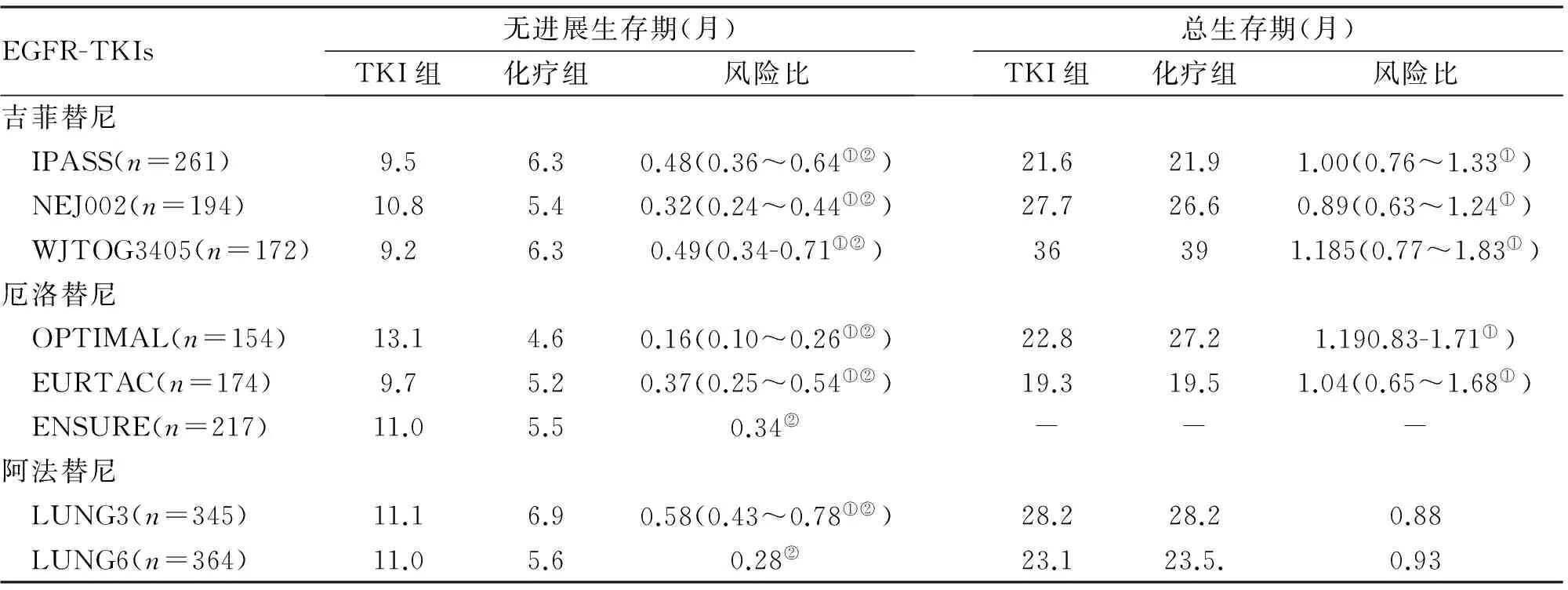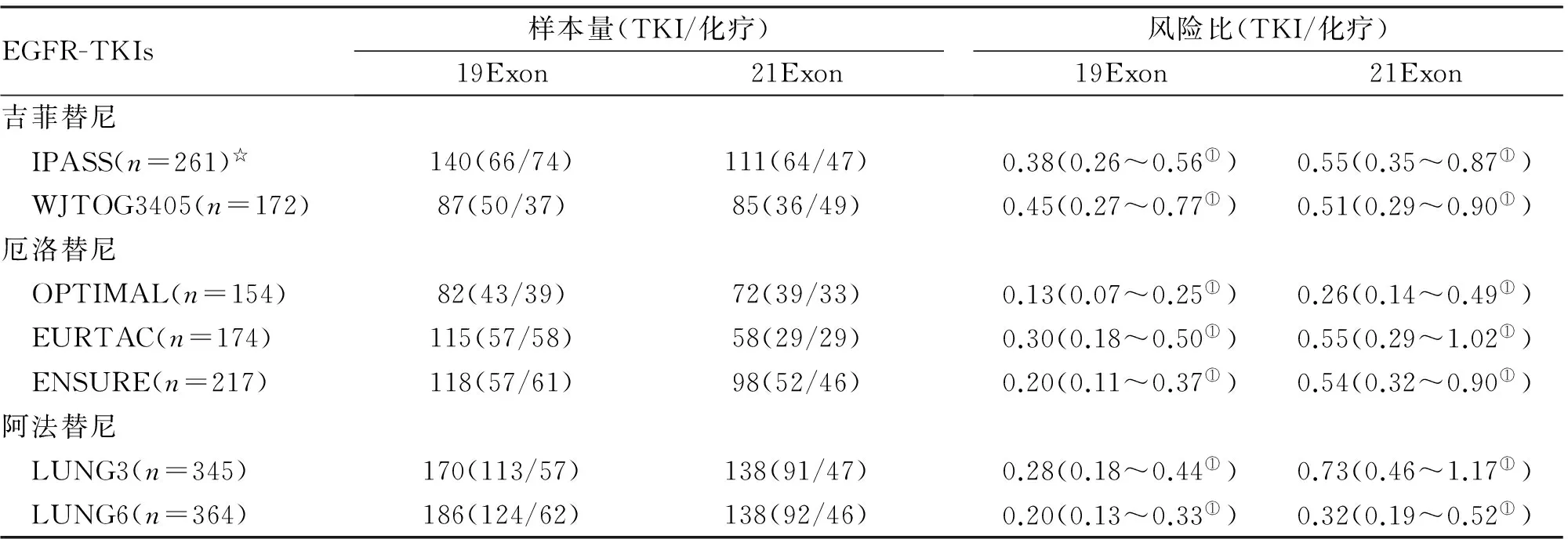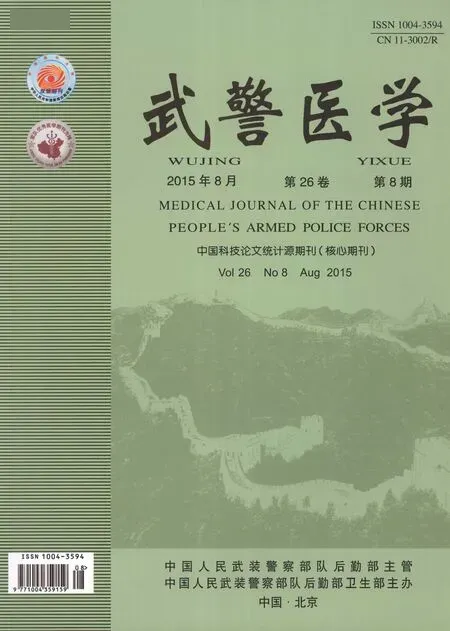内皮生长因子受体突变非小细胞肺癌精准个体化治疗
胡兴胜
专家论坛
内皮生长因子受体突变非小细胞肺癌精准个体化治疗
胡兴胜
内皮生长因子受体;非小细胞肺癌;靶向治疗;基因突变
肺癌是一种严重威胁人类健康的疾病,发病率和死亡率均为癌症之首,其中80%~85%以上为非小细胞肺癌(non-small cell lung cancer, NSCLC)[1]。这些患者中60%以上初次发现时肿瘤已失去手术治疗或根治性放射治疗的机会[2]。因此,全身抗肿瘤治疗措施在肺癌综合治疗中越来越发挥重大作用。
NSCLC的治疗已进入个体化和靶向治疗时代,目前研究数据显示,超过一半的肺腺癌可以检测出驱动基因,且针对绝大部分的驱动基因都有相应的靶向药物上市或处于在研状态[3、4]。其中,内皮生长因子受体(endothelial growth factor receptor, EGFR)突变患者在高加索裔患者中占10%~20%[5];PIONEER研究显示,亚裔肺腺癌患者中EGFR突变率则高达50%以上[6]。目前已经上市的表皮生长因子受体小分子酪氨酸激酶抑制药(EGFR-TKIs)包括吉非替尼、厄洛替尼和阿法替尼,已在八个大型的Ⅲ期、随机、对照临床研究中证实(表1)[7-17],与含铂双药化疗相比,一线给予EGFR-TKIs治疗EGFR突变的晚期NSCLC患者,可以延长患者的无疾病进展时间(progression-free survival, PFS),并提高患者的客观缓解率(objective response rate, ORR)。但是,EGFR-TKIs应用于不同EGFR突变类型患者的疗效是否存在差异,目前尚无定论。为此,笔者主要就这一问题的研究进展进行介绍。
1 EGFR-TKIs对总体EGFR突变的NSCLC患者的疗效是否优于化疗
EGFR是一种蛋白酪氨酸激酶受体,位于第7号染色体p13~q22区,全长200 kb,由28个外显子组成,编码1186个氨基酸[18],其糖蛋白分子量约170 ku[19]。EGFR家族有4个结构相似的受体分子,即ErbBl(EGFR)、ErbB2(HER2)、ErbB3 (HER3)和ErbB4(HER4),同属于受体酪氨酸激酶(RTKS)。它们都含有1个胞外配体结合结构域,1个跨膜结构域和1个具有酪氨酸激酶活性的胞浆结构域[20]。异常的EGFR活化机制包括受体本身的扩增、受体配体的过表达、活化突变,以及负性调节途径的缺乏。因此,EGFR诱导癌症至少通过EGFR配体的过表达、EGFR的扩增或EGFR的突变活化3种机制[21]。其中,EGFR的突变活化是导致肿瘤细胞异常生物学行为的最主要因素。EGFR的主要突变位点包括18~21外显子,且以19外显子缺失突变和21外显子点突变(L858R)最为常见,占所有EGFR突变的85%~90%[22, 23]。
如前所述,已有多个临床研究证实,与EGFR野生型患者相比,EGFR活化突变的NSCLC患者从EGFR-TKIs的治疗中获益更多,且无论是PFS还是ORR都显著高于含铂双药化疗方案[7-17, 24, 25]。
2 EGFR-TKIs对19外显子缺失和21外显子点突变患者的疗效是否存在差异
研究表明,EGFR-TKIs应用于不同EGFR突变类型患者的效果不尽相同。Lee等[26]通过对比170例EGFR突变阳性NSCLC患者一线应用EGFR-TKIs疗效及预后发现,不同亚型的EGFR突变患者应用EGFR-TKIs疗效不同。其中,E746起始的19外显子缺失突变患者应用EGFR-TKIs药物后相对L747起始的缺失突变患者无进展生存期(progression free survival, PFS)更长;而21外显子点突变患者PFS比L861R/L861Q突变患者更长。
由于EGFR-TKIs对于EGFR非常见突变患者的疗效目前还不是十分确切,所以笔者重点关注EGFR-TKIs对EGFR敏感突变(19外显子缺失和21外显子点突变)患者中的疗效是否存在差异。Riely等[25]于2006年对34例肺癌患者进行研究,对比了19外显子缺失突变或21外显子点突变患者应用TKIs药物的效果,发现19外显子缺失突变患者1年OS(总生存期)及中位OS明显优于21外显子点突变患者,且具有统计学意义(90%vs44%,34个月vs8个月,P<0.01)。

表1 EGFR-TKIs一线治疗EGFR突变NSCLC患者的经典临床研究
注:TKI组就是表中的3个药,化疗组就是3代化疗药联合铂类;①表示95%可信区间;②P<0.05
Zhang等[26]在2014年ASCO上汇总分析阿法替尼对比化疗一线治疗EGFR常见突变的NSCLC的两个大型、开放III期临床研究(LUX-Lung 3 和LUX-Lung 6)的总生存数据,无论是单独研究分析还是探索性合并分析结果均显示,与化疗相比,19外显子缺失突变患者一线接受阿法替尼治疗可明显提高OS(Lux-lung 3:33.3个月vs21.1个月,风险比 0.54,P=0.0015; Lux-lung 6:31.4个月vs18.4个月,风险比 0.64,P=0.0229;LUX-Lung 3 & LUX-Lung 6:31.7个月vs20.7个月,风险比0.59,P=0.0001)。但21外显子点突变患者的OS,无论是单独研究分析还是探索性合并分析中,与化疗相比,差异均无统计学意义,并由此得出结论:19外显子缺失突变和21外显子点突变患者可能是两类不同的NSCLC人群,未来应分开进行研究。
虽然目前尚无大样本量的随机对照临床研究证实这一结论,但在既往的大型Ⅲ期临床研究中,对EGFR突变类型应用EGFR-TKI的疗效预设了分层分析。大部分研究结果显示,与对照组化疗相比,无论是19外显子缺失突变还是21外显子点突变的患者,应用EGFR-TKIs均可以显著降低疾病进展的风险,且19外显子缺失突变患者从EGFR-TKIs中获益似乎更多(表2),这点可以从EURTAC[15]研究中的PFS结果得到一些提示。
张力等[26]做了一项荟萃分析,旨在评估EGFR-TKIs(厄洛替尼、吉非替尼、阿法替尼)与化疗在不同敏感突变患者中(19外显子缺失突变和21外显子点)的疗效差异,共入选13项EGFR-TKIs一线治疗EGFR突变阳性NSCLC患者(19外显子缺失突变或21外显子点突变)的临床研究,包括6项Ⅲ期随机对照多中心临床研究,共纳入1382例患者,并采用直接荟萃分析法和间接荟萃分析法进行分析。结果发现,无论是19外显子缺失突变,还是21外显子点突变,EGFR-TKIs较化疗均可显著降低患者的疾病进展风险,分别达72%(风险比=0.28,95%CI:0.20~0.38,P<0.001)和53%(风险比=0.47,95%CI:0.35~0.64,P<0.001),且具有统计学意义。间接荟萃分析结果显示,含铂双药化疗药物对于19外显子缺失突变和21外显子点突变的疗效没有差别,但与21外显子点突变相比,EGFR-TKIs对于19外显子缺失突变的PFS有更多地获益,且具有统计学意义(风险比=0.59, 95%CI: 0.38~0.92,P=0.019)。与在EGFR-TKIs类型(吉菲替尼、厄洛替尼、阿法替尼)分层分析中看到了相似的结果。直接荟萃分析结果同样显示,EGFR-TKIs治疗19外显子缺失突变可以得到一个比21外显子点突变更长的PFS,且具有统计学意义(HR19/21=0.75, 95%CI: 0.65~0.85,P<0.001)。
3 TKIs对19外显子缺失和21外显子点突变具有不同疗效的发生机制
根据小样本临床研究、Ⅲ期临床研究中亚组分析及荟萃分析结果提示,EGFR-TKIs对19外显子缺失和21外显子点突变的疗效可能存在差异,张力等[26]在荟萃分析中提出以下3个假说以解释这一差异产生的可能机制。

表2 EGFR-TKIs一线治疗19外显子缺失突变和21外显子点突变的疗效汇总
注:☆表示261个是突变人群,但其中还有10个其他罕见突变;①表示95%可信区间
3.1 19外显子缺失导致EGFR结构发生改变 从分子水平分析,19外显子缺失突变和21外显子点突变均发生于EGFR分子的酪氨酸激酶区,从空间构象上看,19外显子位于EGFR分子的αC-helix区域,而21外显子位于EGFR分子的A-loop区[27]。Gilmer等[28]等在体外研究评估了吉菲替尼的Ki(抑制常数,即酶抑制药复合物的解离常数,Ki值越低,抑制作用就越强),结果发现,19外显子缺失突变的Ki明显低于21外显子点突变(0.07±0.01vs0.20±0.05),这一结果说明吉菲替尼抑制19外显子缺失突变作用更强,亲和力更高。但是,也有体外研究得出相反的结论,即相同浓度的吉菲替尼对于19外显子缺失和21外显子点突变的抑制作用和EGFR磷酸化程度几乎是相等的[29]。
3.2 21外显子点突变与其他少见突变并存可能影响其对EGFR-TKIs的敏感性 Hata等[30]回顾性分析了783 例NSCLC患者合并突变的发生率,发现21外显子点突变合并G719S突变的发生率最高 (n=8)。Li等[31]在5125例肺癌患者中同样发现, 21外显子点突变与其他突变并存的概率明显高于其他类型的合并突变,其中L858R与T790M合并突变发生率最高(9.8%,15/153),其次是L858R与E545K合并突变(8.5%,13/153)。
3.3 21外显子点突变可能更易发生T790M耐药突变 T790M突变与可逆性EGFR-TKIs的获得性耐药相关[32],且21外显子点突变可能更易发生T790M耐药突变。但是,有研究得出了不一致的结果,显示19外显子缺失突变与21外显子点突变应用EGFR-TKIs后发生获得性耐药突变的概率没有差异(63% vs.61%)[33]。
上述3个假说对于阐述19外显子缺失和21外显子点突变对TKIs疗效不同的发生机制尚存争议。Sordella等[34]报道,19外显子缺失突变和21外显子点突变可能导致EGFR分子自身磷酸化的位点不一样,而致其下游的信号通路不同,比如相对于19外显子缺失突变,21外显子点突变中的845密码子编码的酪氨酸残基表现出高度磷酸化的状态。这也可能是19外显子缺失突变患者相对21外显子点突变患者对TKIs药物反应率较高、预后较好的原因。
综上所述,对于EGFR突变的晚期NSCLC患者,与化疗相比,一线使用EGFR-TKIs可以使患者获益更多。所有EGFR突变类型疗效可能不尽相同,19外显子缺失患者可较21外显子点突变患者,可能会从EGFR-TKIs一线治疗中获得更长的PFS,但需要大样本、前瞻性临床研究进一步探索和验证。
[1] Navada S, Lai P, Schwartz A G,etal. Temporal trends in smallcell lung cancer: analysis of the national surveillance, epidemiology, and end-results (SEER) database[J]. J Clin Oncol, 2006, 24(18 Suppl):7082.
[2] Ginsberg R J, Goldberg M, Waters P E. Surgery in non-small lung cancer. In: Roth J A, Ruckdeschel J C, Weisenberger T H, editors. Thoracic Oncology[M]. 2nd ed. Philadelphia: W.B. Saunders Company,1995: 124-146.
[3] Rosell R, Moran T, Queralt C,etal.Spanish Lung Cancer Group. Screening for epidermal growth factor receptor mutations in lung cancer[J]. N Engl J Med,2009, 361(10): 958-967.
[4] SHI Yuankai, Joseph Siu-Kie A, Thongprasert S,etal. A prospective, molecular epidemiology study of EGFR mutations in Asian patients with advanced non-small-cell lung cancer of adenocarcinoma histology (PIONEER) [J]. J Tho Oncol, 2014, 9 (2): 154-162.
[5] Mok T S, Wu Y L, Thongprasert S,etal. Gefitinib or carboplatin-paclitaxelin pulmonary adenocarcinoma[J]. N Engl J Med, 2009, 361(10): 947-957.
[6] Fukuoka M, Wu YL, Thongprasert S,etal. Biomarker analyses and finaloverall survival results from a phase III, randomized, open-label, first-linestudy of gefitinib versus carboplatin/paclitaxel in clinically selectedpatients with advanced non-small-cell lung cancer in Asia (IPASS) [J]. J Clin Oncol, 2011, 29(21): 2866-2874.
[7] Mitsudomi T, Morita S, Yatabe Y,etal; West Japan Oncology Group. Gefitinib versus cisplatin plus docetaxel in patients with non-small-celllung cancer harbouring mutations of the epidermal growth factor receptor(WJTOG3405): an open label, randomised phase 3 trial[J]. Lancet Oncol, 2010,11(2): 121-128.
[8] Maemondo M, Inoue A, Kobayashi K,etal; North-East Japan StudyGroup. Gefitinib or chemotherapy for non-small-cell lung cancer with mutated EGFR[J]. N Engl J Med, 2010, 362(25): 2380-2388.
[9] Inoue A, Kobayashi K, Maemondo M,etal. Updated overall survivalresults from a randomized phase III trial comparing gefitinib with carboplatin-paclitaxel for chemo-naive non-small cell lung cancer with sensitive EGFR gene mutations (NEJ002) [J]. Ann Oncol, 2013, 24(1): 54-59.
[10] Han J Y, Park K, Kim S W,etal. First-SIGNAL: first-line single-agentiressa versus gemcitabine and cisplatin trial in never-smokers with adenocarcinomaof the lung[J]. J Clin Oncl, 2012, 30(10): 1122-1128.
[11] Zhou C C, Wu Y L, Chen G Y,etal. Erlotinib versus chemotherapy as firstlinetreatment for patients with advanced EGFR mutation-positivenon-small-cell lung cancer (OPTIMAL, CTONG-0802): amulticentre,open-label, randomised, phase 3 study[J]. Lancet Oncol, 2011,12(8): 735-742.
[12] Zhou C C, Wu Y L, Liu X,etal. Overall survival (OS) results from OPTIMAL(CTONG0802), a phase III trial of erlotinib (E) versus carboplatin plusgemcitabine (GC) as first-line treatment for Chinese patients with EGFRmutation-positive advanced non-small cell lung cancer (NSCLC) [J]. J Clin Oncol, 2012, 30(Suppl): 7520.
[13] Rosell R, Carcereny E, Gervais R,etal. Erlotinib versus standard chemotherapyas first-line treatment for European patients with advanced EGFR mutation-positive non-small-cell lung cancer (EURTAC): a multicentre,open-label, randomised phase 3 trial [J]. Lancet Oncol, 2012, 13(3): 239-246.
[14] Sequist L V, Yang J C, Yamamoto N,etal. Phase III study of afatinib or cisplatin plus pemetrexed in patients with metastatic lung adenocarcinomawith EGFR mutations[J]. J Clin Oncol, 2013, 31(27): 3327-3334.
[15] Wu Y L, Zhou C C, Hu C P,etal. LUX-Lung 6: a randomized, openlabel,phase III study of afatinib (A) versus gemcitabine/cisplatin (GC)as first-line treatment for Asian patients (pts) with EGFR mutationpositive(EGFR M+) advanced adenocarcinoma of the lung[J]. J Clin Oncol, 2013, 31: 8016-8023.
[16] Reiter J L, Threadgill D W, EleyGD,etal. Comparative genomic sequence analysis and isolation of human and mouse alternative EGFR transcripts encoding truncated receptor iso-fomls [J]. Genomics, 2001, 71(1):1-5.
[17] Urich A, Coussens L, Hayrick J S,etal. Human epidermal growth factor receptor eDNA sequence and aberrant expression of the amplified gene in A341 epidermoid carcinoma cells[J]. Nature,1984, 309(5967): 418-425.
[18] Ono M, Kuwano M.Molecular mechanisms of epidermal growth factor receptor (EGFR) activation and response to gefitinib and other EGFR-Targeting drugs [J]. Clin Cancer Res, 2006, 12(24): 7242-7250.
[19] Wu Jiahong, Xie Qiuling, Chen Xiaojia. Epidermal growth factor receptor and signal pathway[J]. Chinese Bulletin of Life Sciences, 2006, 18(2):116.
[20] Shigematsu H, Lin L, Takahashi T,etal. Clinical and biological featuresssociated with epidermal growth factor receptor gene mutations in lungcancers[J]. J Natl Cancer Inst, 2005, 97(5): 339-346.
[21] Sharma S V, Bell D W, Settlemanetal J. Epidermal growth factor receptormutations in lung cancer [J]. Nat Rev Cancer, 2007, 7(3):169-181.
[22] Lee C K, Brown C, Gralla R J,etal. Impact of EGFR inhibitor in non-small cell lung cancer on progression-free and overallsurvival: a meta-analysis[J]. J Natl Cancer Inst, 2013, 105: 595-605.
[23] Paz-Ares L, Soulieres D, Melezinek I,etal. Clinical outcomes in non-small-cell lung cancer patients with EGFR mutations: pooled analysis[J]. J Cell Mol Med, 2010, 14(1-2): 51-69.[24] Lee V H, Tin V P, Choy T S,etal. Association of exon 19 and 21 EGFRmutation patterns with treatment outcome after first-line tyrosine kinaseinhibitor in metastatic non-small-cell lung cancer[J]. J ThoracOncol, 2013, 8(9): 1148-1155.
[25] Riely G J, Pao W, Pham D,etal. Clinical course of patients with non-smallcell lung cancer and epidermal growth factor receptor exon 19 and exon 21mutations treated with gefitinib or erlotinib [J]. Clin Cancer Res, 2006, 12(3): 839-844.
[26] Zhang Yaxiong, Sheng Jin, Zhang Li,etal. Patients with exon 19 deletion were associated with longer progression-free survival compared to those with L858R mutation after first-line EGFR-TKIs for advanced non-small cell lung cancer: a meta-analysis [J]. PLoS One, 2014, 9(9): e107161.
[27] Gazdar A F, Minna J D. Inhibition of EGFR signaling: all mutations arenotcreated equal [J]. PLoS Med, 2005, 2(11): e377.
[28] Gilmer T M, Cable L, Alligood K,etal. Impact of common epidermal growth factor receptor and HER2 variants on receptor activity and inhibition by lapatinib [J]. Cancer Res, 2008, 68(2): 571-579.
[29] Mukohara T, Engelman J A, Hanna N H,etal. Differential effects of gefitinib and cetuximab on non-small-cell lung cancersbearing epidermal growth factor receptor mutations [J]. J Natl Cancer Inst, 2005, 97(16): 1185-1194.
[30] Hata A, Yoshioka H, Fujita S,etal. Complex mutations in the epidermal growth factor receptor gene in non-small cell lungcancer [J]. J Thorac Oncol, 2010, 5(10): 1524-1528.
[31] Li S, Li L, Zhu Y,etal. Coexistence of EGFR with KRAS, or BRAF,or PIK3CA somatic mutations in lung cancer:a comprehensive mutation profiling from5125 Chinese cohorts [J]. Br J Cancer, 2014, 110(11): 2812-2820.
[32] Kobayashi S, Boggon T J, Dayaram T,etal. EGFRmutation and resistance of non-small-cell lung cancer to gefitinib [J]. N Engl J Med, 2005, 352: 786-792.
[33] Oxnard G R, Arcila M E, Sima C S,etal. Acquired resistance to EGFR tyrosine kinase inhibitors in EGFR-mutant lung cancer: distinct natural history of patients with tumors harboring the T790M mutation [J]. Clin Cancer Res, 2011, 17(6): 1616-1622.
[34] Sordella R, Bell D W, Haber D A,etal. Gefitinib-sensitizing EGFR mutationsin lung cancer activate anti-apoptotic pathways [J]. Science, 2004, 305(5687): 1163-1167.
(2015-05-20收稿 2015-07-15修回)
(责任编辑 武建虎)
胡兴胜,硕士,主任医师,E-mail:huxingsheng66@163.com
100021 北京,中国医学科学院肿瘤医院内科
R734.2

